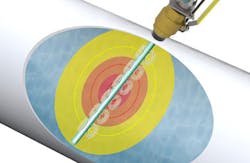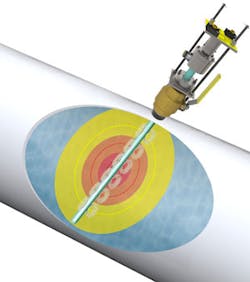By Nicholas Voss, McCrometer
Figure 1
Magnetic flowmeters on two rugged Texas brine disposal lines supporting the U.S. Strategic Petroleum Reserve were recently tested to confirm their accuracy, performance and reliability.
The magnetic, or “mag” meters, were first selected for periodic brine-line testing in 1996. “For years we have counted on this flowmeter to perform testing. To date we have always performed the tests successfully,” said James Nguyen, senior pipeline engineer, DM Petroleum Operations Co.
New Orleans-based DM Petroleum Operations Co., formerly known as DynMcDermott, manages and operates the petroleum reserve under contract to the U.S. Department of Energy and has done so since 1993, including two Louisiana and two Texas storage sites. With a capacity of 727 million barrels, the reserve is the world’s largest stockpile of government-owned emergency crude oil.
Established after the 1973-74 oil embargo, the reserve is a powerful response option should oil-supply disruption threaten the U.S. economy. It supports the country’s obligation to the International Energy Agency to maintain emergency oil stocks. It is a national defense fuel reserve.
Oil is stored in man-made salt domes created by injecting fresh water into salt deposits. Dissolving the salt leaves an open cavern for storage. To retrieve oil from a cavern, water is pumped in at the bottom and oil rises to the surface for transfer to interstate pipelines or ship loading. When oil is added into storage, the brine water is pumped out for disposal.
Mission statement
The U.S. Environmental Protection Agency (EPA) requires periodic leak-detection integrity tests on each brine disposal line at the storage sites. Flow rate is measured simultaneously on-shore and at a site miles out into the Gulf of Mexico near the dispersion nozzles. The meters are transported by barge offshore and inserted for testing purposes. Afterwards, they’re removed from the line and stored until the next tests.
The measured onshore and offshore flows are compared to determine if the pipeline leaks. The criterion for a successful test is a difference of 4% or less between the two measurements.
Two lines in Texas are tested once each year, usually between May and June when the weather tends to be calm and before the hurricane season starts. The Big Hill Brine Line in Jefferson County, Texas is a 14-mile long, 48-inch diameter pipe. It is one of DOE’s toughest flow-metering applications. The second site is a 24-inch pipeline located about six miles offshore. In the past, a pitot-tube type meter profiled the pipe and measured flow at the two points.
The amount of time it took divers to do the flow profiling on the Gulf sea floor, and the less-than-satisfactory results led to a search for better measurement means.
For the Big Hill Brine line, a lift boat — i.e., a barge with legs — transports the meters and divers to the offshore site. Once there, the legs are lowered to lift the barge off the water, providing a stable working platform. Divers locate the opening in the pipe at a depth of about 40 feet and insert the flowmeter sensor. Brine is flowed through the pipe. Flow data is collected and recorded at one-minute intervals for a minimum two-hour test period.
The same type test is conducted on-shore. The on-shore crew connects the flowmeter converter directly to a laptop to receive live flow rates. The integrated system then compares the offshore and onshore measurements. A difference of 4% or less is considered a successful test. The results are submitted to the EPA. Based on the results, the EPA determines whether to renew SPR’s discharge permit.
Flow-metering chronology
FPI Mag Flowmeters first replaced the problematic pitot-tube meters on the Big Hill Brine Line over a required two-hour period in June of 1996. The recorded flows from the FPI Mag flowmeters matched to within 0.21%. The original FPI Mag meters and its subsequent generations have been in continuous use for periodic testing ever since. The latest test confirms their performance results.
“Accuracy is extremely important to the testing process because of time and money,” said Nguyen. “We can’t afford to have equipment that is not working properly. The annual test cost for the contracting alone is $200,000 to cover the lift boat, a five-man diver team and equipment set-up. Plus we have our own offshore and onshore crews.”
It bears adding that the FPI Mag meter combines the ease of hot-tap installation with an accurate measurement across the full-flow profile. The FPI Mag meter is accurate to ± 0.5% from 1 ft/s to 32 ft/s, and ± 1% from 0.3 ft/s to 1 ft/s of reading. It installs in line sizes from 4 to 138 inches.
Because of its compact insertion design, the meter fits into limited-access, confined spaces. It can be removed from pipes under pressure without a shutdown and re-start sequence.
Mag meters operate under the principle of Faraday’s Law of Electromagnetic Induction to measure water velocity. A conductor, such as water, moving through a magnetic field produces a voltage that is directly proportional to the water’s velocity.
Just a few specs
The FPI Mag flowmeter sensor has multiple electrodes across the entire pipe diameter (see Figure 1). Electromagnetic coils installed inside of the sensor produce magnetic fields. Stainless-steel electrode pairs installed on the outside of the sensor collect the induced voltage caused by the flowing water. The total of each voltage signal is transmitted to the converter electronics, to derive an average flow velocity. The converter then multiplies the average flow velocity by the pipe’s cross-sectional area to derive a volumetric flow rate.
Long upstream and downstream straight pipe runs aren’t required. The meter compensates for variable flow profiles, including swirl, turbulence and low-flow conditions. Average flow rate is reported for the pipe’s full diameter. The meter’s signal converter, besides 4-20mA outputs, has programmable outlets for SCADA.
In the brine application, the meter’s 316 stainless-steel sensor body is supplemented with Hastelloy electrodes compatible with the corrosive seawater environment.
“Over the years the meter has been upgraded from the original fiberglass construction to steel. The more rugged the product is the better for this tough environment. We need to rely on the equipment to perform accurately and properly so no re-testing is needed. I’m not sure if any other meter could have been chosen to do the job with the given requirements,” said Nguyen.
After more than a decade of periodic testing service, the FPI Mag Flowmeter continues to demonstrate performance accuracy in demanding environments. The meter’s unique multi-point sensing capability combined with intelligent signal conversion and a robust package design make it an excellent choice in a wide range of industrial-process water-measurement applications.
Nicholas Voss is a product manager at McCrometer.
Hemet, Calif.-based McCrometer develops innovative, precision flowmeters for demanding liquid, steam and gas-measurement industry applications.



